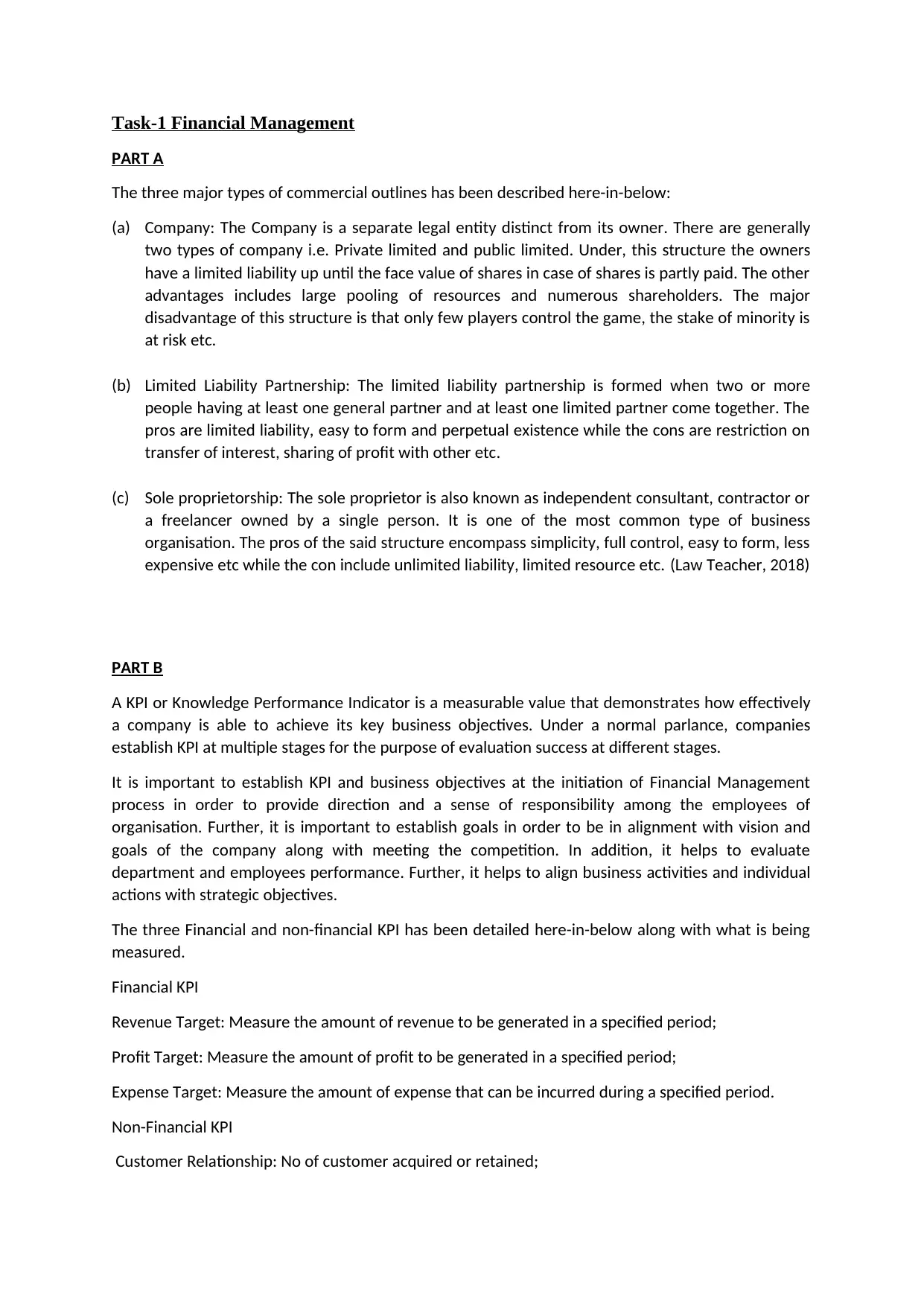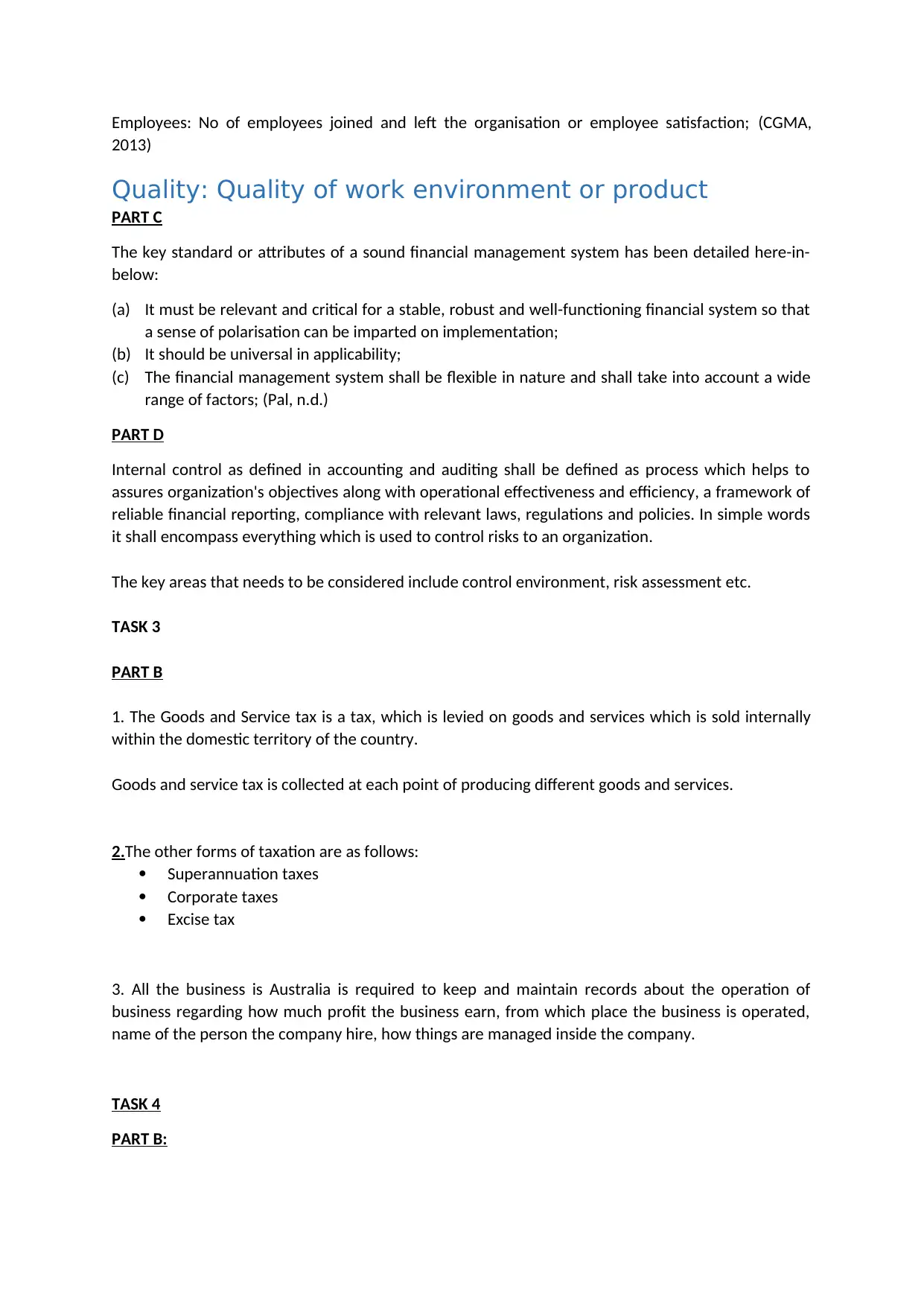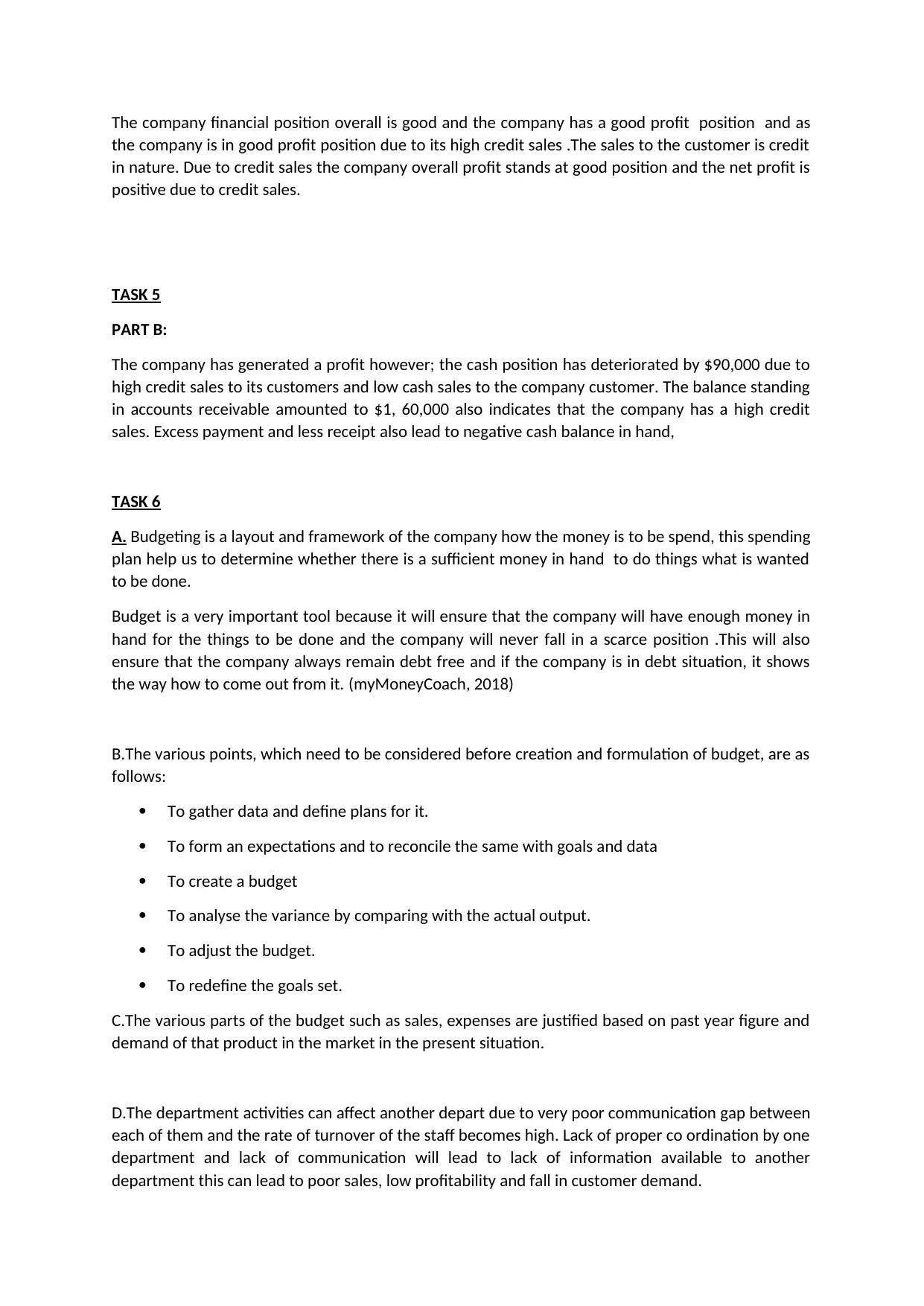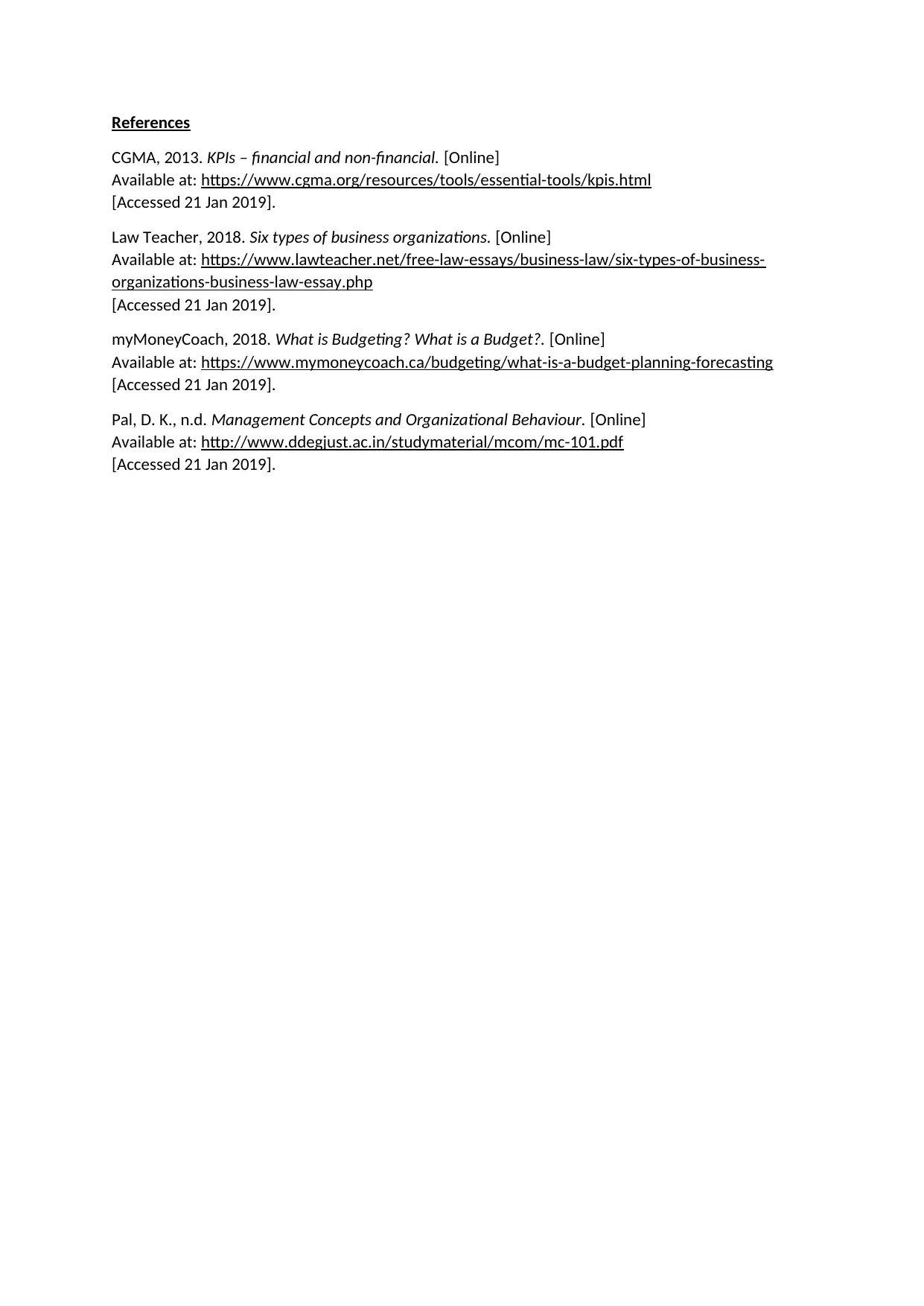Types of Commercial Outlines, KPIs, Financial Management System, Taxation, Budgeting and Department Activities
VerifiedAdded on 2023/04/23
|4
|1311
|212
AI Summary
This document explains about the types of commercial outlines, KPIs, financial management system, taxation, budgeting and department activities. It also explains about the key standard or attributes of a sound financial management system.
Contribute Materials
Your contribution can guide someone’s learning journey. Share your
documents today.

Task-1 Financial Management
PART A
The three major types of commercial outlines has been described here-in-below:
(a) Company: The Company is a separate legal entity distinct from its owner. There are generally
two types of company i.e. Private limited and public limited. Under, this structure the owners
have a limited liability up until the face value of shares in case of shares is partly paid. The other
advantages includes large pooling of resources and numerous shareholders. The major
disadvantage of this structure is that only few players control the game, the stake of minority is
at risk etc.
(b) Limited Liability Partnership: The limited liability partnership is formed when two or more
people having at least one general partner and at least one limited partner come together. The
pros are limited liability, easy to form and perpetual existence while the cons are restriction on
transfer of interest, sharing of profit with other etc.
(c) Sole proprietorship: The sole proprietor is also known as independent consultant, contractor or
a freelancer owned by a single person. It is one of the most common type of business
organisation. The pros of the said structure encompass simplicity, full control, easy to form, less
expensive etc while the con include unlimited liability, limited resource etc. (Law Teacher, 2018)
PART B
A KPI or Knowledge Performance Indicator is a measurable value that demonstrates how effectively
a company is able to achieve its key business objectives. Under a normal parlance, companies
establish KPI at multiple stages for the purpose of evaluation success at different stages.
It is important to establish KPI and business objectives at the initiation of Financial Management
process in order to provide direction and a sense of responsibility among the employees of
organisation. Further, it is important to establish goals in order to be in alignment with vision and
goals of the company along with meeting the competition. In addition, it helps to evaluate
department and employees performance. Further, it helps to align business activities and individual
actions with strategic objectives.
The three Financial and non-financial KPI has been detailed here-in-below along with what is being
measured.
Financial KPI
Revenue Target: Measure the amount of revenue to be generated in a specified period;
Profit Target: Measure the amount of profit to be generated in a specified period;
Expense Target: Measure the amount of expense that can be incurred during a specified period.
Non-Financial KPI
Customer Relationship: No of customer acquired or retained;
PART A
The three major types of commercial outlines has been described here-in-below:
(a) Company: The Company is a separate legal entity distinct from its owner. There are generally
two types of company i.e. Private limited and public limited. Under, this structure the owners
have a limited liability up until the face value of shares in case of shares is partly paid. The other
advantages includes large pooling of resources and numerous shareholders. The major
disadvantage of this structure is that only few players control the game, the stake of minority is
at risk etc.
(b) Limited Liability Partnership: The limited liability partnership is formed when two or more
people having at least one general partner and at least one limited partner come together. The
pros are limited liability, easy to form and perpetual existence while the cons are restriction on
transfer of interest, sharing of profit with other etc.
(c) Sole proprietorship: The sole proprietor is also known as independent consultant, contractor or
a freelancer owned by a single person. It is one of the most common type of business
organisation. The pros of the said structure encompass simplicity, full control, easy to form, less
expensive etc while the con include unlimited liability, limited resource etc. (Law Teacher, 2018)
PART B
A KPI or Knowledge Performance Indicator is a measurable value that demonstrates how effectively
a company is able to achieve its key business objectives. Under a normal parlance, companies
establish KPI at multiple stages for the purpose of evaluation success at different stages.
It is important to establish KPI and business objectives at the initiation of Financial Management
process in order to provide direction and a sense of responsibility among the employees of
organisation. Further, it is important to establish goals in order to be in alignment with vision and
goals of the company along with meeting the competition. In addition, it helps to evaluate
department and employees performance. Further, it helps to align business activities and individual
actions with strategic objectives.
The three Financial and non-financial KPI has been detailed here-in-below along with what is being
measured.
Financial KPI
Revenue Target: Measure the amount of revenue to be generated in a specified period;
Profit Target: Measure the amount of profit to be generated in a specified period;
Expense Target: Measure the amount of expense that can be incurred during a specified period.
Non-Financial KPI
Customer Relationship: No of customer acquired or retained;
Secure Best Marks with AI Grader
Need help grading? Try our AI Grader for instant feedback on your assignments.

Employees: No of employees joined and left the organisation or employee satisfaction; (CGMA,
2013)
Quality: Quality of work environment or product
PART C
The key standard or attributes of a sound financial management system has been detailed here-in-
below:
(a) It must be relevant and critical for a stable, robust and well-functioning financial system so that
a sense of polarisation can be imparted on implementation;
(b) It should be universal in applicability;
(c) The financial management system shall be flexible in nature and shall take into account a wide
range of factors; (Pal, n.d.)
PART D
Internal control as defined in accounting and auditing shall be defined as process which helps to
assures organization's objectives along with operational effectiveness and efficiency, a framework of
reliable financial reporting, compliance with relevant laws, regulations and policies. In simple words
it shall encompass everything which is used to control risks to an organization.
The key areas that needs to be considered include control environment, risk assessment etc.
TASK 3
PART B
1. The Goods and Service tax is a tax, which is levied on goods and services which is sold internally
within the domestic territory of the country.
Goods and service tax is collected at each point of producing different goods and services.
2.The other forms of taxation are as follows:
Superannuation taxes
Corporate taxes
Excise tax
3. All the business is Australia is required to keep and maintain records about the operation of
business regarding how much profit the business earn, from which place the business is operated,
name of the person the company hire, how things are managed inside the company.
TASK 4
PART B:
2013)
Quality: Quality of work environment or product
PART C
The key standard or attributes of a sound financial management system has been detailed here-in-
below:
(a) It must be relevant and critical for a stable, robust and well-functioning financial system so that
a sense of polarisation can be imparted on implementation;
(b) It should be universal in applicability;
(c) The financial management system shall be flexible in nature and shall take into account a wide
range of factors; (Pal, n.d.)
PART D
Internal control as defined in accounting and auditing shall be defined as process which helps to
assures organization's objectives along with operational effectiveness and efficiency, a framework of
reliable financial reporting, compliance with relevant laws, regulations and policies. In simple words
it shall encompass everything which is used to control risks to an organization.
The key areas that needs to be considered include control environment, risk assessment etc.
TASK 3
PART B
1. The Goods and Service tax is a tax, which is levied on goods and services which is sold internally
within the domestic territory of the country.
Goods and service tax is collected at each point of producing different goods and services.
2.The other forms of taxation are as follows:
Superannuation taxes
Corporate taxes
Excise tax
3. All the business is Australia is required to keep and maintain records about the operation of
business regarding how much profit the business earn, from which place the business is operated,
name of the person the company hire, how things are managed inside the company.
TASK 4
PART B:

The company financial position overall is good and the company has a good profit position and as
the company is in good profit position due to its high credit sales .The sales to the customer is credit
in nature. Due to credit sales the company overall profit stands at good position and the net profit is
positive due to credit sales.
TASK 5
PART B:
The company has generated a profit however; the cash position has deteriorated by $90,000 due to
high credit sales to its customers and low cash sales to the company customer. The balance standing
in accounts receivable amounted to $1, 60,000 also indicates that the company has a high credit
sales. Excess payment and less receipt also lead to negative cash balance in hand,
TASK 6
A. Budgeting is a layout and framework of the company how the money is to be spend, this spending
plan help us to determine whether there is a sufficient money in hand to do things what is wanted
to be done.
Budget is a very important tool because it will ensure that the company will have enough money in
hand for the things to be done and the company will never fall in a scarce position .This will also
ensure that the company always remain debt free and if the company is in debt situation, it shows
the way how to come out from it. (myMoneyCoach, 2018)
B.The various points, which need to be considered before creation and formulation of budget, are as
follows:
To gather data and define plans for it.
To form an expectations and to reconcile the same with goals and data
To create a budget
To analyse the variance by comparing with the actual output.
To adjust the budget.
To redefine the goals set.
C.The various parts of the budget such as sales, expenses are justified based on past year figure and
demand of that product in the market in the present situation.
D.The department activities can affect another depart due to very poor communication gap between
each of them and the rate of turnover of the staff becomes high. Lack of proper co ordination by one
department and lack of communication will lead to lack of information available to another
department this can lead to poor sales, low profitability and fall in customer demand.
the company is in good profit position due to its high credit sales .The sales to the customer is credit
in nature. Due to credit sales the company overall profit stands at good position and the net profit is
positive due to credit sales.
TASK 5
PART B:
The company has generated a profit however; the cash position has deteriorated by $90,000 due to
high credit sales to its customers and low cash sales to the company customer. The balance standing
in accounts receivable amounted to $1, 60,000 also indicates that the company has a high credit
sales. Excess payment and less receipt also lead to negative cash balance in hand,
TASK 6
A. Budgeting is a layout and framework of the company how the money is to be spend, this spending
plan help us to determine whether there is a sufficient money in hand to do things what is wanted
to be done.
Budget is a very important tool because it will ensure that the company will have enough money in
hand for the things to be done and the company will never fall in a scarce position .This will also
ensure that the company always remain debt free and if the company is in debt situation, it shows
the way how to come out from it. (myMoneyCoach, 2018)
B.The various points, which need to be considered before creation and formulation of budget, are as
follows:
To gather data and define plans for it.
To form an expectations and to reconcile the same with goals and data
To create a budget
To analyse the variance by comparing with the actual output.
To adjust the budget.
To redefine the goals set.
C.The various parts of the budget such as sales, expenses are justified based on past year figure and
demand of that product in the market in the present situation.
D.The department activities can affect another depart due to very poor communication gap between
each of them and the rate of turnover of the staff becomes high. Lack of proper co ordination by one
department and lack of communication will lead to lack of information available to another
department this can lead to poor sales, low profitability and fall in customer demand.

References
CGMA, 2013. KPIs – financial and non-financial. [Online]
Available at: https://www.cgma.org/resources/tools/essential-tools/kpis.html
[Accessed 21 Jan 2019].
Law Teacher, 2018. Six types of business organizations. [Online]
Available at: https://www.lawteacher.net/free-law-essays/business-law/six-types-of-business-
organizations-business-law-essay.php
[Accessed 21 Jan 2019].
myMoneyCoach, 2018. What is Budgeting? What is a Budget?. [Online]
Available at: https://www.mymoneycoach.ca/budgeting/what-is-a-budget-planning-forecasting
[Accessed 21 Jan 2019].
Pal, D. K., n.d. Management Concepts and Organizational Behaviour. [Online]
Available at: http://www.ddegjust.ac.in/studymaterial/mcom/mc-101.pdf
[Accessed 21 Jan 2019].
CGMA, 2013. KPIs – financial and non-financial. [Online]
Available at: https://www.cgma.org/resources/tools/essential-tools/kpis.html
[Accessed 21 Jan 2019].
Law Teacher, 2018. Six types of business organizations. [Online]
Available at: https://www.lawteacher.net/free-law-essays/business-law/six-types-of-business-
organizations-business-law-essay.php
[Accessed 21 Jan 2019].
myMoneyCoach, 2018. What is Budgeting? What is a Budget?. [Online]
Available at: https://www.mymoneycoach.ca/budgeting/what-is-a-budget-planning-forecasting
[Accessed 21 Jan 2019].
Pal, D. K., n.d. Management Concepts and Organizational Behaviour. [Online]
Available at: http://www.ddegjust.ac.in/studymaterial/mcom/mc-101.pdf
[Accessed 21 Jan 2019].
1 out of 4
Related Documents
Your All-in-One AI-Powered Toolkit for Academic Success.
+13062052269
info@desklib.com
Available 24*7 on WhatsApp / Email
![[object Object]](/_next/static/media/star-bottom.7253800d.svg)
Unlock your academic potential
© 2024 | Zucol Services PVT LTD | All rights reserved.



